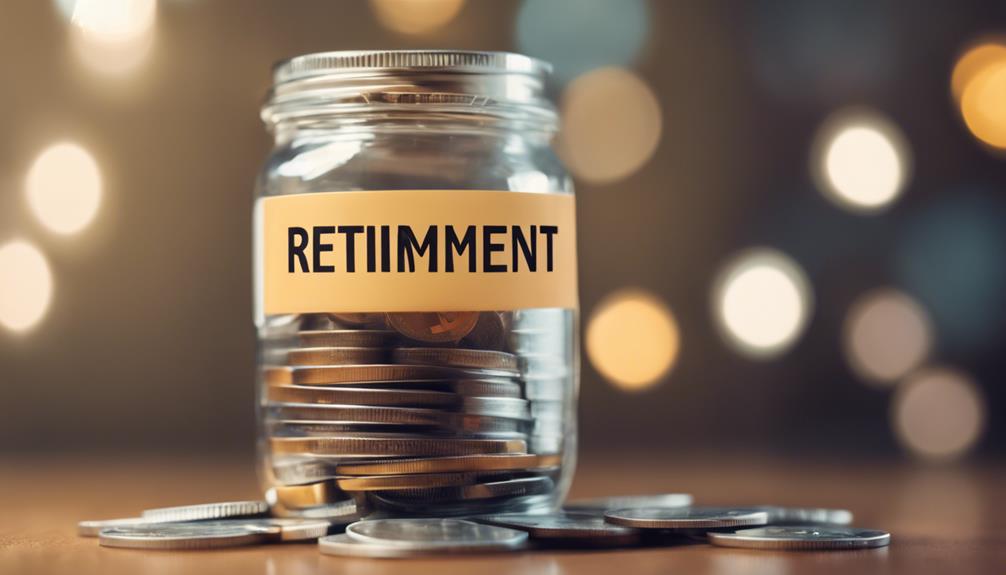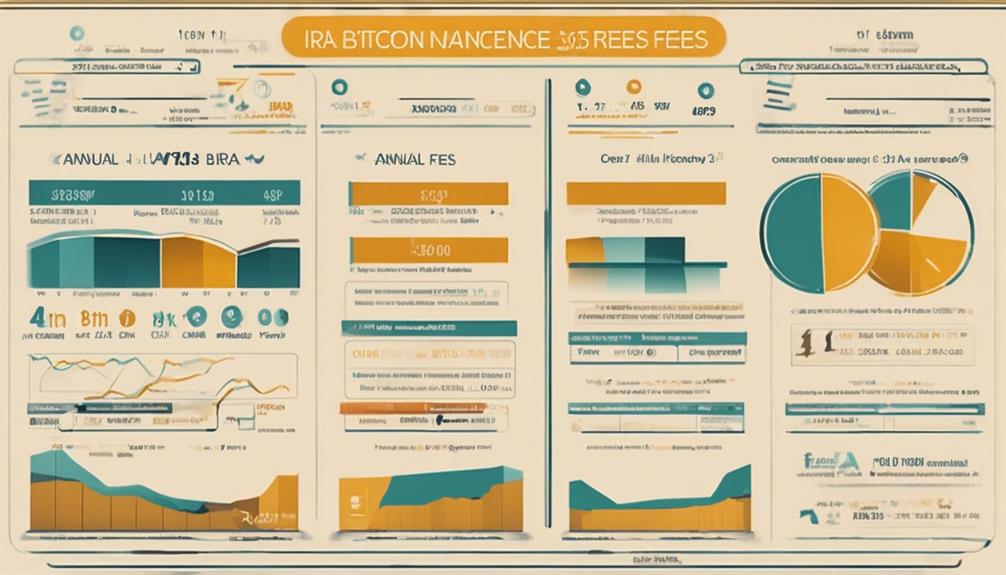Enhance retirement portfolios with Bitcoin IRA investments to diversify beyond traditional assets. Bitcoin IRAs offer tax advantages like tax-deferred gains and potential tax-free growth, broadening investment horizons. Despite risks from cryptocurrency volatility, aligning with long-term goals and proper custodian selection are key. Contribution limits are set, and diversification strategies across cryptocurrencies can spread risk. Efficiently monitor performance using tracking tools to optimize portfolios. Looking ahead, regulatory changes and mainstream adoption may drive growth. Understanding benefits, risks, and strategies can lay a strong foundation for a secure financial future.
Key Takeaways
- Bitcoin IRAs offer diversification beyond traditional assets.
- Cryptocurrency investments can enhance portfolio resilience.
- Bitcoin IRAs provide exposure to a growing asset class.
- Diversifying with Bitcoin IRAs can hedge against market volatility.
- Including Bitcoin IRAs can optimize long-term growth potential.
Understanding Bitcoin IRAs

Let's explore the concept of Bitcoin IRAs, self-directed retirement accounts tailored for investing in cryptocurrencies like Bitcoin. Bitcoin IRAs provide an avenue for individuals to include digital assets in their retirement portfolios, offering a unique investment opportunity. One key advantage of a Bitcoin IRA is the ability to diversify holdings beyond traditional assets like stocks and bonds, allowing for exposure to the potential growth of cryptocurrencies. This diversification can help guarantee risk management and enhance long-term growth prospects for retirement savings.
Moreover, Bitcoin IRAs come with tax advantages that make them a compelling option for retirement planning. Gains from cryptocurrency sales within the IRA are tax-deferred, providing investors with the opportunity to grow their investments without immediate tax implications. Additionally, contributions to Bitcoin IRAs have set limits, with $7,000 for 2024 or $8,000 for individuals aged 50 or older. This structured approach ensures that investors can plan their retirement savings effectively while taking advantage of the potential growth in digital assets.
Benefits of Bitcoin IRA Investment

Bitcoin IRAs offer significant benefits such as tax advantages, allowing for tax-deferred gains and tax-free reinvestment until withdrawal.
Investing in a Bitcoin IRA also enables diversification in retirement beyond traditional assets like stocks and bonds.
Tax Advantages of Bitcoin IRA
When investing in a Bitcoin IRA, one can benefit from tax advantages that allow for potential tax-free growth on gains from Bitcoin sales. Gains in a Bitcoin IRA are tax-deferred, providing the opportunity for tax-free growth until withdrawal.
Depending on the type of IRA, there may be zero short-term and long-term tax implications on gains, offering a tax-efficient investment option. Roth Bitcoin IRAs, specifically, may enable tax-free withdrawals during retirement, making them a favorable choice for those seeking tax advantages.
Diversification in Retirement
Diversifying one's retirement portfolio through a Bitcoin IRA can provide numerous benefits, including risk mitigation and the potential for enhanced returns. By including cryptocurrencies in a self-directed IRA, investors can access a non-correlated asset class, reducing reliance on traditional investments. This diversification can act as a hedge against inflation and economic uncertainties, offering long-term growth potential. Bitcoin IRAs not only add variety to retirement savings but also have the potential to boost overall portfolio performance. Consider the table below for a clearer comparison of Bitcoin IRAs with traditional retirement investments:
| Aspect | Bitcoin IRA |
|---|---|
| Risk Mitigation | High |
| Potential Returns | Enhanced |
| Diversification Benefits | Significant |
| Investment Opportunities | Cryptocurrencies |
Risks Associated With Bitcoin IRAS

Understanding the potential risks of investing in a Bitcoin IRA is essential for making informed financial decisions for retirement planning. Bitcoin IRAs are considered critical due to the high volatility of cryptocurrencies. Market fluctuations can lead to significant value swings in a Bitcoin IRA, posing challenges for a retirement portfolio.
Additionally, the speculative nature of cryptocurrencies can introduce further risks, impacting the overall stability of the investment. Early withdrawal penalties and potential income tax implications are also important risks associated with Bitcoin IRAs that investors need to take into account.
Being aware of these risks and understanding the volatility of Bitcoin IRAs is vital for making informed decisions when it comes to retirement planning. By recognizing and evaluating these risks, individuals can better assess whether a Bitcoin IRA aligns with their long-term financial goals and risk tolerance levels.
Opening a Bitcoin IRA Account

To begin investing in a Bitcoin IRA account, one must first identify a custodian that supports cryptocurrency investments and align their investment objectives with the available account types. Opening a Bitcoin IRA involves providing personal information, comparing fees, and selecting a suitable custodian to manage your digital assets securely.
By choosing a custodian that specializes in crypto investments, individuals can guarantee that their retirement accounts are in line with their financial goals. Bitcoin IRAs offer a unique opportunity to diversify traditional retirement portfolios with cryptocurrency investments while potentially benefiting from tax advantages.
Choosing a Bitcoin IRA Custodian

Selecting a reliable Bitcoin IRA custodian is paramount for safeguarding investments and ensuring regulatory compliance in cryptocurrency retirement accounts. When choosing a custodian, consider the following:
- Research: Thoroughly investigate potential custodians, looking into their reputation, experience, and reviews to guarantee they're trustworthy and capable of managing your Bitcoin IRA effectively.
- Fees: Compare fee structures among different custodians to understand the costs involved in maintaining your account. Be aware of account maintenance fees, transaction fees, and any other charges that may apply.
- Track Record: Assess the custodian's track record in managing Bitcoin IRAs. Look for a history of secure storage practices, regulatory compliance, and successful facilitation of digital asset trading within retirement accounts. A proven track record can provide confidence in the custodian's ability to handle your investments securely and in accordance with regulations.
Tax Implications of Bitcoin IRAs

As we explore the tax implications of Bitcoin IRAs, it's essential to contemplate how different types of IRAs can impact the taxation of gains in retirement accounts. Gains in Bitcoin IRAs are typically taxed based on income after retirement.
Roth IRAs offer tax-free gains on withdrawals, while traditional IRAs may have deferred tax benefits. Understanding the detailed information in the Bitcoin IRA tax guide is vital for managing tax implications effectively.
It's noteworthy that tax implications for Bitcoin IRAs depend on the type of IRA, with the potential for zero short-term and long-term taxes in certain cases. Choosing a reputable Bitcoin IRA provider and complying with custodial rules are essential for managing tax obligations and ensuring compliance with IRS regulations.
Bitcoin IRA Contribution Limits

When contemplating a Bitcoin IRA, it's crucial to understand the contribution limits set for each age group.
In 2024, individuals under 50 can contribute up to $7,000, while those over 50 have a higher limit of $8,000.
Understanding these limits helps us avoid penalties and optimize our retirement savings effectively.
Contribution Limits Overview
For Bitcoin IRAs in 2024, the contribution limits stand at $7,000, while individuals aged 50 or older can contribute up to $8,000. When considering Bitcoin IRAs, it's important to understand the contribution limits to maximize retirement savings effectively. Here are three key points to keep in mind:
- Benefit of Age: Individuals over 50 have the advantage of a higher contribution limit, allowing them to boost their retirement portfolio more notably.
- Diversification Potential: The set contribution limits encourage diversification within Bitcoin IRAs, enabling investors to spread their investments across various digital assets.
- Planning Consideration: Understanding the contribution limits helps in planning and strategizing the allocation of funds for optimal growth within a Bitcoin IRA.
Annual Maximum Allowed
Moving on to the current subtopic of 'Annual Maximum Allowed' in Bitcoin IRA Contribution Limits, let's focus on the set limits for 2024 to understand the potential for retirement savings growth.
For the year 2024, the annual contribution limit for a Bitcoin IRA stands at $7,000. Individuals who are 50 years or older have the opportunity to contribute up to $8,000 annually to their Bitcoin IRA. These contribution limits are applicable to both Traditional and Roth Bitcoin IRAs and may be adjusted according to IRS regulations and guidelines.
Following these set limits is essential for maximizing retirement savings through a Bitcoin IRA, providing a valuable opportunity to diversify your portfolio for long-term financial security.
Exceeding Contribution Penalties
Exceeding the Bitcoin IRA contribution limits set for 2024 can lead to penalties, including potential tax consequences and scrutiny from the IRS. To avoid these repercussions, it's essential to stay within the prescribed limits and guarantee compliance with IRS regulations. If you find yourself in a situation of over-contribution, taking corrective actions promptly is vital to rectify the excess amount and mitigate any tax implications.
Understanding the implications of exceeding the Bitcoin IRA contribution limits is key to managing your retirement savings effectively and safeguarding your financial future.
- Compliance is Key: Adhering to the set contribution limits is fundamental to avoid penalties.
- Prompt Corrective Actions: Timely rectification of over-contributions is necessary to address any tax implications.
- IRS Scrutiny: Exceeding the limits may trigger scrutiny from the IRS, emphasizing the importance of staying within the boundaries.
Diversification Strategies for Bitcoin IRAs

In crafting diversification strategies for Bitcoin IRAs, we focus on allocating funds across a mix of cryptocurrencies to spread risk effectively. By diversifying the portfolio with various cryptocurrencies, we aim to enhance potential returns while mitigating the impact of market volatility. Utilizing a combination of high-performing cryptocurrencies alongside those with lower risk profiles can help balance the overall risk exposure. Rebalancing the portfolio periodically based on market conditions and performance is essential to optimizing investment outcomes. This systematic approach to diversification is key to achieving long-term growth and stability in a Bitcoin IRA.
| Cryptocurrency | Risk Level | Market Performance |
|---|---|---|
| Bitcoin | Medium | High |
| Ethereum | High | High |
| Ripple | Low | Medium |
| Litecoin | Medium | Low |
Monitoring Bitcoin IRA Performance
When monitoring Bitcoin IRA performance, it's important to utilize performance tracking tools to keep tabs on the value of your investments.
Setting clear investment goals can help you measure the success of your Bitcoin IRA against relevant benchmarks.
Regularly reviewing your account guarantees that you stay informed about your cryptocurrency holdings' growth and performance.
Performance Tracking Tools
Performance tracking tools play a vital role in monitoring the value and growth of cryptocurrency investments within a Bitcoin IRA. These tools provide real-time updates on the performance of Bitcoin and other cryptocurrencies in the IRA, allowing users to track historical data, price trends, and portfolio allocations.
By leveraging performance tracking tools, investors can gain insights into investment strategies, risk management, and potential returns for their Bitcoin IRAs. This thorough monitoring enables informed decision-making and adjustments to optimize the retirement portfolio effectively.
- Real-time updates on cryptocurrency performance.
- Historical data analysis for informed decisions.
- Portfolio allocation insights for risk management and optimization.
Setting Investment Goals
How can we effectively monitor the performance of our Bitcoin IRA by setting clear investment goals?
To begin, it's vital to define our investment goals based on factors such as desired returns, risk tolerance, and time horizon. By establishing these objectives, we create a roadmap for evaluating the performance of our Bitcoin IRA in line with our financial objectives and retirement plans.
Utilizing performance metrics and portfolio trackers allows us to track the growth and profitability of our Bitcoin investments within the IRA. Additionally, adjusting our investment strategy as needed based on the performance of Bitcoin and market conditions ensures alignment with our goals.
Regularly comparing our Bitcoin IRA's performance to benchmark indices and industry standards provides insight into its effectiveness in diversifying our retirement portfolio.
Regular Account Reviews
Consistently monitoring our Bitcoin IRA account guarantees that we stay informed about the performance of our cryptocurrency investments. By conducting regular account reviews, we can assess the growth or decline of our retirement portfolio and make informed decisions about our investment strategy.
Monitoring our Bitcoin IRA performance allows us to stay updated on market trends, enabling us to seize potential opportunities for maximizing returns. It also helps us proactively manage our retirement savings in the volatile crypto market. Remember, staying vigilant with account reviews is key to adapting to the dynamic nature of cryptocurrency investments. Stay informed, stay proactive, and stay ahead in your investment journey.
- Assess growth or decline of retirement portfolio.
- Make informed decisions about investment strategy.
- Seize opportunities for maximizing returns.
Future Outlook for Bitcoin IRAs

Looking ahead, the potential for growth in Bitcoin IRAs appears promising as regulatory developments continue to shape the landscape of cryptocurrency investing in retirement accounts. The recent SEC approval of 11 bitcoin ETFs in January, despite not explicitly endorsing the underlying digital assets, indicates a growing investor interest in diversified crypto investments within retirement plans. While institutional workplace 401(k) plans are facing regulatory pushback, the SEC's decision to allow US exchanges to list spot bitcoin funds could further legitimize cryptocurrency investing in personal retirement savings vehicles. Additionally, the mainstream adoption of bitcoin-linked products by financial giants like BlackRock and Fidelity, outperforming bitcoin futures funds, showcases a shift towards embracing cryptocurrencies in traditional investment portfolios.
| Regulatory Developments | Impact on Bitcoin IRAs | Potential Growth Opportunities |
|---|---|---|
| SEC Approval of Bitcoin ETFs | Increasing investor interest | Diversification in retirement accounts |
| US Exchanges Listing Spot Bitcoin Funds | Legitimizing cryptocurrency investing | Broadening investment options |
| Pushback on Workplace 401(k) Crypto Investments | Slowing adoption | Regulatory hurdles to overcome |
Frequently Asked Questions
Is It a Good Idea to Have a Bitcoin Ira?
It can be a good idea to have a Bitcoin IRA depending on your investment goals and risk tolerance. Bitcoin IRAs offer potential for significant returns and can help diversify your retirement portfolio.
While there are risks like market volatility and high fees, the tax advantages and potential for growth can make it appealing for some investors. Consulting with a financial advisor is recommended to determine if a Bitcoin IRA aligns with your retirement strategy.
How Do I Diversify My IRA Portfolio?
When diversifying your IRA portfolio, consider spreading funds across various assets like:
- Stocks
- Bonds
- Real estate
- Cryptocurrencies
This strategy can help reduce risk and potentially increase returns. Factor in your risk tolerance, investment goals, and time horizon when making decisions.
Seeking guidance from a financial advisor can help tailor a diversified IRA portfolio to meet your specific needs and objectives. Remember, diversification is key to managing risk and enhancing long-term growth potential.
Can You Fund an IRA With Bitcoin?
Yes, you can fund an IRA with Bitcoin. Opening a self-directed IRA designed for cryptocurrency investments allows for more control over your retirement savings.
This option permits investing in alternative assets like Bitcoin, offering potential for diversification, significant returns, and tax advantages. Approximately 3-5% of all IRAs are invested in alternative assets, including cryptocurrencies like Bitcoin.
Utilize crypto exchanges, custodians, and secure storage solutions for managing your digital assets.
What Is the Best Mix for a Retirement Portfolio?
When considering the best mix for a retirement portfolio, factors like risk tolerance, investment goals, time horizon, and financial situation are crucial. A well-diversified approach typically includes stocks, bonds, real estate, and alternative assets such as Bitcoin.
Allocating around 5% to 10% to Bitcoin can enhance diversification and potentially boost returns. Consulting a financial advisor is key to finding the perfect balance between risk and potential returns for your retirement portfolio.
What are the Benefits of Diversifying a Retirement Portfolio with Bitcoin IRA Investments?
Diversifying your retirement portfolio with ultimate bitcoin IRA investment options can offer potential benefits, such as a hedge against inflation and currency devaluation. Bitcoin IRA investments may provide diversification, potential growth, and exposure to a non-correlated asset class that could help balance and strengthen your overall retirement portfolio.
Conclusion
To sum up, diversifying your retirement portfolio with a Bitcoin IRA can offer unique benefits and risks worth considering.
As you navigate the world of cryptocurrency investments, remember to stay informed, monitor performance, and adjust your strategy accordingly.
Will you take the leap into the world of Bitcoin IRAs to secure your financial future? The choice is yours.











